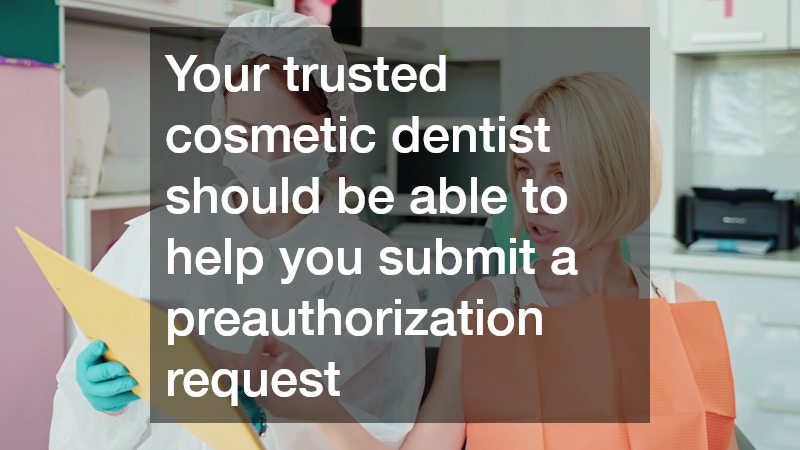
Highlights:
-
Always confirm if your cosmetic dentist accepts your insurance plan and is in-network.
-
Ask which cosmetic procedures (like crowns or bonding) may qualify for coverage.
-
Request a written pre-treatment estimate or preauthorization before starting.
-
Clarify payment plans and how claims are handled for non-covered services.
-
Provide documentation that proves medical necessity to boost coverage chances.
-
Explore insurance-covered alternatives for costly cosmetic treatments.
-
Understand policy limits, exclusions, and waiting periods to plan financially.

If you’ve ever looked into getting a whiter, straighter, or more confident smile, you’ve probably noticed something: cosmetic dental procedures can get pricey fast. That’s why one of the most common concerns patients have before booking is whether their insurance covers cosmetic dentistry—or how to find a cosmetic dentist who accepts insurance in the first place.
The tricky part is that most cosmetic dental treatments are considered elective, meaning they’re not always covered by dental insurance. But there are exceptions—and understanding those can save you hundreds, sometimes even thousands, of dollars.
Before committing to a smile makeover or any cosmetic procedure, it’s smart to come prepared with the right questions for your dentist. Here’s a detailed guide to help you navigate that conversation confidently.
Why Insurance Coverage Matters in Cosmetic Dentistry
Cosmetic dentistry is about improving how your teeth look, but it often overlaps with restorative treatments that affect your oral health. For instance, replacing a chipped tooth with a crown can be considered cosmetic—but it also restores function, which may qualify it for insurance coverage.
That’s where knowing the right questions comes in. A cosmetic dentist that accepts insurance can help you figure out which parts of your treatment plan might be covered, and which will come out of pocket.
Understanding insurance coverage before your appointment helps you:
-
Avoid financial surprises. Some cosmetic procedures look simple but involve lab work, multiple visits, and materials that increase the cost.
-
Compare treatment options. Your dentist might suggest different materials or techniques based on what your insurance plan covers.
-
Plan your budget wisely. If you know what’s covered, you can schedule cosmetic work over time or use financing for the uncovered portion.
What to Ask a Cosmetic Dentist About Insurance Coverage

When searching for a cosmetic dentist that accepts insurance, it’s not enough to just ask “Do you take insurance?” Instead, dig deeper. Here are key questions to ask—along with why each one matters.
1. “Do You Accept My Dental Insurance Plan?”
This is the most obvious question, but it’s essential. Not every cosmetic dentist works with every insurer. Some may be “in-network,” which means they’ve agreed to your insurer’s pricing structure, while others are “out-of-network,” which might mean higher out-of-pocket costs.
What to discuss:
-
Which insurance providers the dental office works with.
-
Whether the dentist is in-network or out-of-network.
-
What documentation they provide if you need to file claims yourself.
-
How payment and reimbursements are handled.
If you already have a specific procedure in mind—say veneers or bonding—ask whether your insurance provider has any restrictions or requirements for those treatments.
2. “Which Cosmetic Procedures Are Typically Covered by Insurance?”
Insurance rarely covers procedures done purely for aesthetics, like whitening or veneers. But some cosmetic treatments overlap with restorative dentistry, which may qualify for partial coverage.
Here are some examples:
| Procedure | Possible Coverage | Why It Might Be Covered |
|---|---|---|
| Crowns | Partial | Restores tooth structure and function after decay or damage |
| Bonding | Partial | Repairs chips, cracks, or decay |
| Implants | Partial (for medical necessity) | Replaces missing teeth, restores function |
| Orthodontics (Braces/Invisalign) | Sometimes | Covered if needed to correct bite issues |
| Tooth-colored fillings | Yes | Considered restorative rather than cosmetic |
Follow-up questions:
-
Does my policy cover procedures that improve both appearance and function?
-
Are there annual maximums or waiting periods for cosmetic work?
-
Does the insurance company require pre-approval before treatment?
Knowing the answers helps you plan realistically and avoid unexpected denials.
3. “Can You Provide a Pre-Treatment Estimate or Preauthorization?”
Your trusted cosmetic dentist should be able to help you submit a preauthorization request. This is a document your dentist sends to your insurance company outlining the proposed treatment plan and costs. The insurer reviews it and tells you how much they’ll cover.
This step gives you clarity before committing financially.
Ask your dentist:
-
Will you send a preauthorization request to my insurer?
-
How long does it usually take to get a response?
-
Will you provide a written cost estimate before starting treatment?
Getting this information in writing helps you avoid confusion and gives you leverage if billing disputes arise later.
4. “What Are My Payment Options for Non-Covered Services?”
Even with insurance, many cosmetic treatments will require some out-of-pocket spending. Before you get that smile makeover, ask your dentist what payment options they offer.
Common options include:
-
Flexible payment plans. Spread payments over several months.
-
Third-party financing. Companies like CareCredit or LendingClub offer low- or no-interest dental loans.
-
Discounts for upfront payment. Some offices offer small discounts for paying the full balance upfront.
-
In-house membership plans. Certain dental offices provide annual plans with discounts on cosmetic services.
Cosmetic dentists that accept insurance often have flexible payment systems to make aesthetic treatments more affordable. The goal is to make your dream smile achievable without overwhelming your budget.
5. “Do You File Insurance Claims on My Behalf?”
Many patients assume their dentist automatically handles insurance paperwork, but not all do. Some cosmetic dentists may require you to file claims yourself—especially if they’re out-of-network.
Ask clearly:
-
Will your office file claims with my insurance company?
-
If not, can you provide the necessary itemized receipts and procedure codes?
-
Will you assist me if I need to appeal a denied claim?
Having the office handle the process can save you hours of paperwork and follow-up calls.
6. “What Documentation Will My Insurance Company Need?”
When it comes to coverage, details matter. Insurers often want proof that a procedure is medically necessary. For example, if you’re getting veneers because your teeth were damaged in an accident, you may qualify for partial reimbursement.
Ask your dentist to provide:
-
X-rays or digital scans showing damage or decay.
-
Notes describing the medical reason for treatment.
-
Diagnostic codes (used by insurers for processing claims).
-
A written treatment plan detailing all steps and costs.
This paperwork helps maximize your benefits and avoid claim rejections.
7. “Can You Recommend Alternative Treatments That Insurance Covers?”
A reliable cosmetic dentist who accepts insurance won’t just push the most expensive option. They’ll work with you to find alternatives that deliver aesthetic results while qualifying for coverage.
For example:
-
Instead of full veneers, ask if dental bonding could fix smaller chips or discolorations.
-
Instead of cosmetic implants, see if a bridge or partial denture might be covered.
-
Instead of laser whitening, consider professional take-home whitening trays that cost less.
Discuss:
-
The pros and cons of each alternative.
-
How long the results last compared to the premium option.
-
What portion of each option insurance might cover.
This conversation can help you balance beauty, function, and affordability.
8. “How Often Can I Use My Cosmetic Benefits?”
Some insurance plans limit how often they’ll cover certain treatments. For example, you might only get coverage for a crown replacement every five years, or whitening only once per year.
Ask your dentist:
-
Are there waiting periods before coverage starts?
-
Are there frequency limitations for specific procedures?
-
Do benefits reset annually, or do they roll over?
Knowing your benefit timeline helps you plan long-term smile maintenance without wasting coverage opportunities.
9. “Do You Offer a Complimentary Consultation?”
Many cosmetic dentists offer free or low-cost consultations. This is the perfect time to discuss your insurance situation, get a treatment quote, and understand what’s covered before you start.
A cosmetic dentist that accepts insurance may also have staff who specialize in helping patients navigate coverage questions. Take advantage of that! Bring your insurance card, policy details, and any questions you have.
During your consultation, ask:
-
Can you show me before-and-after photos of patients with similar treatments?
-
Can we go over my insurance benefits together?
-
Can I get a written estimate with both insured and uninsured costs listed?
This helps you make an informed, pressure-free decision.
10. “What Happens If My Insurance Doesn’t Pay?”
Sometimes, even with preauthorization, insurance companies deny or limit coverage. Ask your dentist upfront how they handle that situation.
Important details to clarify:
-
Will you be billed immediately, or can payments be delayed pending appeal?
-
Does the office assist with re-submissions or appeals?
-
What are the average success rates for insurance appeals in your office?
Having clear answers helps you manage expectations and ensures you’re not caught off guard later.
Bonus Tips: How to Find a Cosmetic Dentist That Accepts Insurance
If you haven’t chosen a dentist yet, here’s how to narrow down your options:
1. Check Your Insurance Provider’s Directory
Most dental insurance companies have online directories where you can filter for “cosmetic dentistry” or “restorative dental work.” Look for providers marked as “in-network” to save more.
2. Ask for Referrals
Friends, family, or coworkers who’ve had cosmetic work done can be valuable sources. Ask specifically if their dentist accepted insurance and how smooth the billing process was.
3. Search Online
Use phrases like:
-
“Cosmetic dentist that accepts insurance near me”
-
“Affordable cosmetic dentist with insurance coverage”
-
“Insurance-friendly cosmetic dental care”
Check reviews that mention billing transparency, insurance handling, and payment flexibility.
4. Verify Credentials
Make sure your chosen dentist is licensed and specializes in cosmetic dentistry. Membership in the American Academy of Cosmetic Dentistry (AACD) is a good sign of expertise.
5. Ask About a Consultation
As mentioned, a consultation gives you the chance to evaluate both the dentist’s skill and how well they handle insurance-related questions.
Common Insurance Terms to Know Before You Go
Understanding your policy’s language will help you communicate better with both your dentist and insurer.
| Term | Meaning |
|---|---|
| Deductible | The amount you must pay before insurance starts covering costs. |
| Annual Maximum | The total your insurer will pay within a calendar year. |
| Co-payment (Co-pay) | A fixed amount you pay for a specific service. |
| Preauthorization | Approval from the insurer before treatment begins. |
| Exclusions | Services your policy does not cover (often purely cosmetic ones). |
| Out-of-Network | A provider not contracted with your insurer; costs may be higher. |
Knowing these terms prevents misunderstandings and helps you ask sharper questions.
The Bottom Line
Getting a beautiful smile doesn’t have to drain your wallet—especially if you find a cosmetic dentist that accepts insurance and helps you maximize your benefits. The key is asking smart, specific questions before you commit to treatment.
By discussing coverage, documentation, alternatives, and payment options upfront, you’ll walk into your appointment informed and confident about both your care and your costs.
